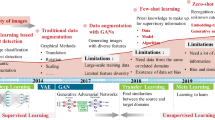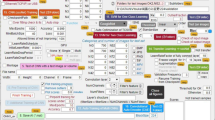Abstract
Visual defect detection, which is pivotal in industrial quality control, often requires extensive datasets for training deep-learning models. However, in industrial environments, the presence of multiple production batches, small lot sizes, and rapidly evolving task requirements make it challenging to acquire sufficient and diverse defect data. To address these challenges, this study introduces an innovative approach to data augmentation and defect detection under few-data conditions. Our strategy employs a two-stage feature-enhancement method complemented by an expert knowledge-based image-generation method. The former ensures robustness in color and richness in feature representation by focusing on local defect irregularities. The latter leverages both the core mechanistic understanding of experts and nonquantitative empirical insights, combined with a variable background domain, to generate rich images with diverse defect features. We evaluated the feasibility and effectiveness of the proposed method using a proprietary dataset curated by an automotive component manufacturing enterprise. The experimental results revealed that, across the five defect categories, training on 2 images achieved an F1-Score of 41.06%, which improved to 67.11% when the training dataset was expanded to 15 images. A comparative analysis with prevailing feature enhancement and image generation methods revealed our solution’s superiority, bridging methodological drawbacks, and markedly eclipsing others in terms of enhancement potency. Furthermore, when benchmarked against additional public industrial datasets, the model exhibited exceptional adaptability and superior performance, thus highlighting its potential as a robust tool for quality control in manufacturing scenarios.
Graphical Abstract



















Similar content being viewed by others
Data availability
The data that support the findings of this study are available on request from the corresponding author XQ W. The data are not publicly available due to them containing information that could compromise the privacy of research participating companies.
References
Escobar CA, McGovern ME, Morales-Menendez R (2021) Quality 4.0: a review of big data challenges in manufacturing. J Intell Manuf 32:2319–2334. https://doi.org/10.1007/s10845-021-01765-4
Gao Y, Li X, Wang XV et al (2022) A review on recent advances in vision-based defect recognition towards Industrial Intelligence. J Manuf Syst 62:753–766. https://doi.org/10.1016/j.jmsy.2021.05.008
Shang H, Sun C, Liu J et al (2023) Defect-aware transformer network for intelligent visual surface defect detection. Adv Eng Inform 55:101882. https://doi.org/10.1016/j.aei.2023.101882
Chow JK, Su Z, Wu J et al (2020) Anomaly detection of defects on concrete structures with the convolutional autoencoder. Adv Eng Inform 45:101105. https://doi.org/10.1016/j.aei.2020.101105
Alzubaidi L, Zhang J, Humaidi AJ et al (2021) Review of deep learning: concepts, CNN architectures, challenges, applications, future directions. J Big Data 8:53. https://doi.org/10.1186/s40537-021-00444-8
Ren R, Hung T, Tan KC (2018) A generic deep-learning-based approach for automated surface inspection. IEEE Trans Cybern 48:929–940. https://doi.org/10.1109/TCYB.2017.2668395
Zhang X, Cai F, Hu X et al (2022) A contrastive learning-based task adaptation model for few-shot intent recognition. Inf Process Manag 59:102863. https://doi.org/10.1016/j.ipm.2021.102863
Singh SA, Kumar AS, Desai KA (2023) Comparative assessment of common pre-trained CNNs for vision-based surface defect detection of machined components. Expert Syst Appl 218:119623. https://doi.org/10.1016/j.eswa.2023.119623
de la López F, Gómez-Sirvent JL, Sánchez-Reolid R et al (2022) Geometric transformation-based data augmentation on defect classification of segmented images of semiconductor materials using a ResNet50 convolutional neural network. Expert Syst Appl 206:117731. https://doi.org/10.1016/j.eswa.2022.117731
Xu Y, Wei S, Bao Y, Li H (2019) Automatic seismic damage identification of reinforced concrete columns from images by a region-based deep convolutional neural network. Struct Control Health Monit 26:e2313. https://doi.org/10.1002/stc.2313
Kaur H, Pannu HS, Malhi AK (2020) A systematic review on imbalanced data challenges in machine learning: applications and solutions. ACM Comput Surv 52:1–36. https://doi.org/10.1145/3343440
Yousefan M, Najafabadi HE, Amirkhani H et al (2022) Deep anomaly detection in hyperspectral images based on membership maps and object area filtering. Expert Syst Appl 191:116200. https://doi.org/10.1016/j.eswa.2021.116200
Bau D, Zhu JY, Wulff J et al (2019) Seeing What a GAN Cannot Generate. In: Proceedings of the IEEE/CVF International Conference on Computer Vision, pp 4502–4511
Yao H, Zhang C, Wei Y et al (2020) Graph few-shot learning via knowledge transfer. AAAI 34:6656–6663. https://doi.org/10.1609/aaai.v34i04.6142
Zhou C, Gu Y, Fang G, Lin Z (2022) Automatic morphological classification of galaxies: convolutional autoencoder and bagging-based multiclustering model. AJ 163:86. https://doi.org/10.3847/1538-3881/ac4245
Hospedales TM, Antoniou A, Micaelli P, Storkey AJ (2021) Meta-learning in neural networks: a Survey. IEEE Trans Pattern Anal Mach Intell 1–1:1. https://doi.org/10.1109/TPAMI.2021.3079209
Wu Y, Lin Y, Dong X et al (2018) Exploit the unknown gradually: one-shot video-based person re-identification by Stepwise Learning. In: 2018 IEEE/CVF Conference on Computer Vision and Pattern Recognition. IEEE, Salt Lake City, UT, pp 5177–5186
Xu Z, Zhu L, Yang Y (2017) Few-shot object recognition from machine-labeled web images. In: 2017 IEEE Conference on Computer Vision and Pattern Recognition (CVPR). IEEE, Honolulu, HI, pp 5358–5366
Wang T, Zhang X, Yuan L, Feng J (2019) Few-shot adaptive faster R-CNN. In: Proceedings of the IEEE/CVF Conference on Computer Vision and Pattern Recognition, pp 7166–7175
Wang K, Liew JH, Zou Y et al (2019) PANet: few-shot image semantic segmentation with prototype alignment. In: 2019 IEEE/CVF International Conference on Computer Vision (ICCV). IEEE, Seoul, Korea (South), pp 9196–9205
Yong G, Jeon K, Gil D, Lee G (2022) Prompt engineering for zero-shot and few-shot defect detection and classification using a visual-language pretrained model. Comput Aided Civil Eng Mice 12954. https://doi.org/10.1111/mice.12954
Wang W, Mi C, Wu Z et al (2022) A real-time steel surface defect detection approach with high accuracy. IEEE Trans Instrum Meas 71:1–10. https://doi.org/10.1109/TIM.2021.3127648
Sheynin S, Benaim S, Wolf L (2021) A hierarchical transformation-discriminating generative model for few shot anomaly detection. In: 2021 IEEE/CVF International Conference on Computer Vision (ICCV). IEEE, Montreal, QC, Canada, pp 8475–8484
Lu Y, Zheng H, Chand S et al (2022) Outlook on human-centric manufacturing towards industry 5.0. J Manuf Syst 62:612–627. https://doi.org/10.1016/j.jmsy.2022.02.001
Jarrahi MH (2018) Artificial intelligence and the future of work: human-AI symbiosis in organizational decision making. Bus Horiz 61:577–586. https://doi.org/10.1016/j.bushor.2018.03.007
Bay H, Ess A, Tuytelaars T, Van Gool L (2008) Speeded-Up robust features (SURF). Comput Vis Image Underst 110:346–359. https://doi.org/10.1016/j.cviu.2007.09.014
Pasadas DJ, Ramos HG, Feng B et al (2020) Defect classification with SVM and wideband excitation in Multilayer Aluminum plates. IEEE Trans Instrum Meas 69:241–248. https://doi.org/10.1109/TIM.2019.2893009
Cheng X, Yu J (2021) RetinaNet with difference channel attention and adaptively spatial feature fusion for steel surface defect detection. IEEE Trans Instrum Meas 70:1–11. https://doi.org/10.1109/TIM.2020.3040485
Jin X, Wang Y, Zhang H et al (2020) DM-RIS: deep multimodel rail inspection system with improved MRF-GMM and CNN. IEEE Trans Instrum Meas 69:1051–1065. https://doi.org/10.1109/TIM.2019.2909940
Zhang Y, Wang W, Li Z et al (2023) Development of a cross-scale weighted feature fusion network for hot-rolled steel surface defect detection. Eng Appl Artif Intell 117:105628. https://doi.org/10.1016/j.engappai.2022.105628
Hao R, Lu B, Cheng Y et al (2021) A steel surface defect inspection approach towards smart industrial monitoring. J Intell Manuf 32:1833–1843. https://doi.org/10.1007/s10845-020-01670-2
Jain S, Seth G, Paruthi A et al (2022) Synthetic data augmentation for surface defect detection and classification using deep learning. J Intell Manuf 33:1007–1020. https://doi.org/10.1007/s10845-020-01710-x
Yang B, Liu Z, Duan G, Tan J (2022) Mask2Defect: a prior knowledge-based data augmentation method for metal surface defect inspection. IEEE Trans Ind Inf 18:6743–6755. https://doi.org/10.1109/TII.2021.3126098
Guo R, Liu H, Xie G, Zhang Y (2021) Weld defect detection from imbalanced radiographic images based on contrast enhancement conditional generative adversarial network and transfer learning. IEEE Sens J 21:10844–10853. https://doi.org/10.1109/JSEN.2021.3059860
Niu S, Li B, Wang X, Lin H (2020) Defect image sample generation with GAN for improving defect recognition. IEEE Trans Automat Sci Eng 1–12:1. https://doi.org/10.1109/TASE.2020.2967415
Zhou F, Yang S, Fujita H et al (2020) Deep learning fault diagnosis method based on global optimization GAN for unbalanced data. Knowl Based Syst 187:104837. https://doi.org/10.1016/j.knosys.2019.07.008
Tsai D-M, Fan S-KS, Chou Y-H (2021) Auto-annotated deep segmentation for surface defect detection. IEEE Trans Instrum Meas 70:1–10. https://doi.org/10.1109/TIM.2021.3087826
Yan L, Zheng Y, Cao J (2018) Few-shot learning for short text classification. Multimed Tools Appl 77:29799–29810. https://doi.org/10.1007/s11042-018-5772-4
Yu R, Guo B, Yang K (2022) Selective prototype network for few-shot metal surface defect segmentation. IEEE Trans Instrum Meas 71:1–10. https://doi.org/10.1109/TIM.2022.3196447
Xiao W, Song K, Liu J, Yan Y (2022) Graph embedding and optimal transport for few-shot classification of metal surface defect. IEEE Trans Instrum Meas 71:1–10. https://doi.org/10.1109/TIM.2022.3169547
Song Y, Liu Z, Ling S et al (2022) Coarse-to-fine few-shot defect recognition with dynamic weighting and joint metric. IEEE Trans Instrum Meas 71:1–10. https://doi.org/10.1109/TIM.2022.3193204
Yun S, Han D, Chun S et al (2019) CutMix: regularization strategy to train strong classifiers with localizable features. In: 2019 IEEE/CVF International Conference on Computer Vision (ICCV). IEEE, Seoul, Korea (South), pp 6022–6031
Zhong Z, Zheng L, Kang G et al (2020) Random erasing data Augmentation. AAAI 34:13001–13008. https://doi.org/10.1609/aaai.v34i07.7000
Arjovsky M, Chintala S, Bottou L (2017) Wasserstein generative adversarial networks. In: International Conference on Machine Learning, pp. 214–223. PMLR
Zhang H, Goodfellow I, Metaxas D, Odena A (2019) Self-attention generative adversarial networks. In: International conference on machine learning, pp. 7354–7363. PMLR
Acknowledgements
This research is supported by National Social Science Fund of China [20BGL108].
Author information
Authors and Affiliations
Contributions
Conceptualization: Yu Gong, Xiaoqiao Wang; Data curation: Y u Gong, Conghu Liu; Investigation: Xiaoqiao Wang, Mingzhou Liu; Methodology: Yu Gong, Xiaoqiao Wang; Project administration: Mingzhou Liu, Conghu Liu; Supervision: Xiaoqiao Wang, Jing Hu; V alidation: Jing Hu; Writing – original draft: Yu Gong; Writing – review & editing: Xiaoqiao Wang.
Corresponding author
Ethics declarations
Competing interests
The authors declare that they have no known competing financial interests or personal relationships that could have appeared to influence the work reported in this paper.
Additional information
Publisher’s Note
Springer Nature remains neutral with regard to jurisdictional claims in published maps and institutional affiliations.
Rights and permissions
Springer Nature or its licensor (e.g. a society or other partner) holds exclusive rights to this article under a publishing agreement with the author(s) or other rightsholder(s); author self-archiving of the accepted manuscript version of this article is solely governed by the terms of such publishing agreement and applicable law.
About this article
Cite this article
Gong, Y., Liu, M., Wang, X. et al. Few-shot defect detection using feature enhancement and image generation for manufacturing quality inspection. Appl Intell 54, 375–397 (2024). https://doi.org/10.1007/s10489-023-05199-8
Accepted:
Published:
Issue Date:
DOI: https://doi.org/10.1007/s10489-023-05199-8




